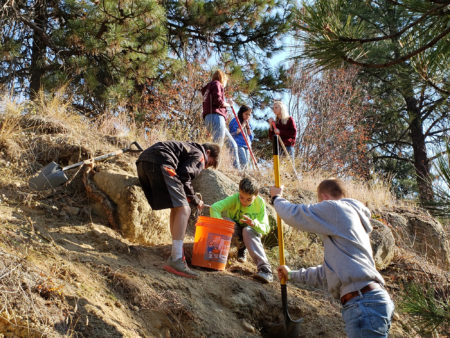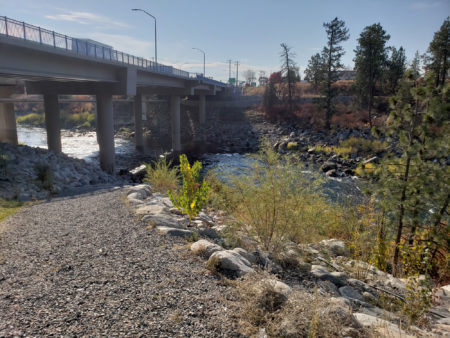City School brings kid power to Sullivan Park shoreline restoration
Kid power is an awesome sight to see. Click here for a photo album of 50 students from City School, a West Valley School District magnet school, helping to reclaim a riparian area through planting at Sullivan Park.
The project helps complete river access and restoration work that the Spokane River Forum and Spokane Conservation District began working on in 2013 with the City of Spokane Valley. “It’s another great example of good things happening for the environment and community when you commit to building long term partnerships and trust-based relationships,” said Spokane River Forum Executive Director Andy Dunau.
With irrepressible excitement and great attitudes, the City School students planted about 300 native plants such as ponderosa pine, service berry and mock orange to revegetate and stabilize about 400’ of hillside along the Spokane River bank. Said Nick Hamm, their teacher, “Part of our school mission is to have students go out into the community every five weeks, and work with experts. We want them to tie what they’re learning in the classroom to helping meet real world needs in the community. This may include community service work, exploring possibilities for their future education or career, and more.”
 On this day, kids rotated between planting activities and being taught a botany lesson by Kelly Samia, an AmeriCorps volunteer with West Valley Outdoor Learning Center. Said Samia, “One thing I wanted to achieve with this lesson is teaching kids that plant biologists don’t just study plants. They can be climatologists and problem-solvers as well, to help meet diverse needs.”
On this day, kids rotated between planting activities and being taught a botany lesson by Kelly Samia, an AmeriCorps volunteer with West Valley Outdoor Learning Center. Said Samia, “One thing I wanted to achieve with this lesson is teaching kids that plant biologists don’t just study plants. They can be climatologists and problem-solvers as well, to help meet diverse needs.”
The City School students are building on restoration work that the Conservation District began in 2015 when about 400’ of fence line and strategically placed boulders were installed to discourage people from going up and down the bank, randomly causing serious erosion issues. At either end, there’s a path to allow people to walk down to the river.
After that work was complete, a pause was taken until the fall to do the planting. This is the time of year when the river level is lower and it’s easier for the new plants to establish roots over the winter. Between planting in optimal growing conditions and the city putting in an irrigation system, the Conservation District is very confident that at least 60% of the plants will survive and the riparian area will be fully restored. To assure the desired outcome, the Conservation District will be monitoring the planting and addressing needs as they arise.
5 Years of Persistence Pays Off
This Spokane River stewardship story dates to 2013 when the City of Spokane Valley asked the Forum and others for input into developing river access as part of the Sullivan Bridge Replacement Project. “They were impressed by the partnerships we built, and the community support received for restoring the Barker Bridge river access after that bridge was built,” said Dunau. “To the city’s credit, they wanted to build on that success with the Sullivan Bridge Replacement Project.”
What resulted was the Forum helping facilitate two tracks of activity. One track featured input into the river access design with Spokane Canoe and Kayak Club, the Conservation District and others with deep knowledge of what would be functional and also provide a chance for improved health of the river. The new Sullivan Park river access was completed in 2017 and has received rave reviews by all.
The second track was to restore and protect about 400 feet of shoreline just downstream of the new river access. Said Lindsay Chutas, Riparian Program Leader with the Spokane Conservation District, “This area had been hammered by years of people scrambling up and down the hillside to get to and from the river.”
To deal with human caused and natural erosion, the Conservation District developed a restoration and enhancement plan for revegetation and bank stabilization. To implement the plan, an agreement was struck to access funds the city contributed to WDFW for lost habitat associated with building the new bridge.
“It’s really the ultimate win, win,” said Chutas. “Appropriate and safe water access combined with riparian enhancement and restoration that’s built for the long term.” Add to that city improvements that include a new shelter and improved grounds, and this park has become a community treasure for the Valley.
As Chutas handed another plant to a student she commented, “Andy always preaches the value of persistence and patience. When I look at the results and see these kids getting after it, I gotta agree that five years of work sure is paying off for the river and community.”
